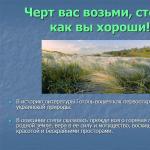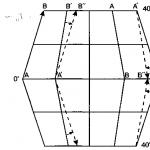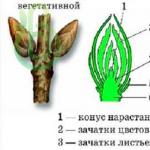Current page: 16 (total book has 26 pages) [accessible reading excerpt: 18 pages]
§ 57. Struggle for existence and its forms
1. What is the essence of Mendel's laws?
2. What are the main provisions of the evolutionary teachings of Darwin.
Thinking about the mechanisms and driving forces of evolution, Charles Darwin came to the idea of struggle for existence. This is one of the central concepts of the theory of evolution. C. Darwin drew attention to the fact that all living beings are inherent in the ability of almost "limitless" reproduction. A female roundworm, for example, produces 200 thousand eggs per day, a gray rat 5 litters per year, an average of 8 rat pups reaching puberty by the age of three months, in one fruit of cuckoo tears there are at least 186,000 seeds. The ability to reproduce rapidly leads to important consequences: with the growth of the intensified competition for resources, the probability of the appearance of new mutations increases and “life pressure” is created, as a result of which there is a struggle for existence. Ch. Darwin repeatedly emphasized that the struggle for existence is not reduced to a direct fight, it is a complex and diverse relationship of organisms within the same species, between different species and with inorganic nature. “I must warn,” Darwin wrote, “that I am using this term in a broad, metaphorical sense ... Of two dogs or wolves in a time of famine, one can rightly say that they are fighting each other for food and thereby for life. But about a plant growing on the edge of the desert, we can say that it is fighting for life against drought. The reward in the struggle for existence is life and the possibility of its continuation in successive generations.
Forms of the struggle for existence. Darwin distinguished three forms of struggle for existence: intraspecific, interspecific and fight against unfavorable conditions of inorganic nature. The most stressful of them intraspecific struggle. A vivid example of intraspecific struggle is the competition between coniferous forest trees of the same age. The tallest trees, with their widely spread crowns, intercept the bulk of the sun's rays, and their powerful root system absorbs dissolved minerals from the soil to the detriment of weaker neighbors. Intraspecific struggle is especially aggravated with an increase in population density, for example, with an abundance of chicks in some bird species (many species of gulls, petrels), the stronger ones push the weaker ones out of the nests, dooming them to death from predators or starvation.
Interspecies struggle can manifest itself in various forms, for example, in the form of competition (competition) for food or other resources, or in the form of the unilateral use of one species by another. An illustrative example of competition for food is provided by the predators of the African savannas (cheetahs, lions, hyenas, hyena dogs, etc.), which often take away caught and killed prey from each other. Often, attractive habitats are the object of competition. For example, in the struggle for a place in human settlements, the gray rat, stronger and more aggressive, eventually replaced the black rat, which is currently found only in forest areas or in deserts. The American mink brought to Europe replaces the native European species. The muskrat (a native of North America) has intercepted some of the resources previously used by native species, such as the Russian muskrat. In Australia, the common bee brought from Europe has supplanted the small, stingless native bee.
The third form of struggle for existence is struggle with adverse external conditions. Factors of inanimate nature have a direct and indirect influence on the evolution of living things. Plants in the desert are said to be "drought-fighting", referring to the development of numerous adaptations that help them extract water and nutrients from the soil (special root system) or reduce transpiration rate (special leaf structure). The conditions of the inorganic world have a significant impact on the evolution of organisms, not only in themselves, their influence can strengthen or weaken intra- and interspecies relationships. With a lack of territory, heat or light, intraspecific struggle intensifies, and vice versa, with an excess of resources necessary for life, it weakens.
Struggle for existence. Forms of struggle for existence: intraspecific, interspecific, with unfavorable conditions.
1. List the main forms of the struggle for existence.
2. What facts allow us to talk about the "pressure of life"?
3. Why is intraspecific struggle the most intense form of struggle for existence?
Based on your own observations, prepare examples that describe the struggle for existence between organisms: a) of the same species; b) different types.
§ 58. Natural selection and its forms
1. What environmental factors can lead to the selection of organisms in nature?
2. Is the relationship between man and nature a selection factor?
The doctrine of natural selection was developed by Charles Darwin, who considered selection itself the result of the struggle for existence, and its prerequisite - the hereditary variability of organisms.
The genetic essence of natural selection is the selective preservation of certain genotypes in a population. The hereditary material contained in them is passed on to the next generations. In this way, natural selection can be defined as the selective reproduction of genotypes that best meet the prevailing living conditions of the population. In Grade 9, you have already become familiar with some examples of the action of natural selection that can be observed in an experiment or in nature. Let us consider another experiment showing how, in the course of natural selection, the relationship between phenotypes and genotypes in a population is carried out. In nature, there are some types of fruit flies that find their favorite food either on the tops of trees or on the surface of the soil, but never in the middle. Is it possible to breed such insects by selection that would fly either only downwards or only upwards? Figure 73 shows a diagram of an experiment demonstrating the effect of selection on the genetic composition of populations. Fruit flies were placed in a labyrinth consisting of many chambers, each of which had two exits - up and down. In each of the chambers, the animal had to "decide" in which direction to move. The flies, constantly moving upwards, ended up at the top exit of the maze. They were carefully selected for subsequent maintenance. The flies moving down ended up in the lower exit of the maze, they were also selected. Insects that remained in the chambers of the labyrinth, i.e., those that did not have a definite direction of movement, were collected and removed from the experiment. "Upper" and "lower" flies were kept and bred separately from each other. Gradually, it was possible to create populations, all individuals of which, without exception, had a certain stereotype of behavior (moving up or down). This result was not associated with the emergence of any new genes, everything happened only due to selection, which affected the variability of phenotypes already present in the population (in this case, the variability in the behavior of flies). Thus, the action of natural selection leads to the fact that phenotypes begin to influence the gene pool of populations. What happens if you remove the pressure of natural selection? To answer this question, the experimenters allowed the flies of the "upper" and "lower" tiers to breed together. Soon, the initial balance of alleles was restored in the population: some individuals moved up, some down, others did not show any preferences in terms of the direction of movement.
Rice. 73. Experiments with fruit flies demonstrating the action of natural selection (maze)
Natural selection changes the composition of the gene pool, "removing" from the population of individuals whose characteristics and properties do not give advantages in the struggle for existence. As a result of selection, the genetic material of "advanced" individuals (that is, those possessing properties that increase their chances in the struggle for life) begins to influence the gene pool of the entire population more and more.
In the course of natural selection, amazing and diverse biological adaptations (adaptation) of organisms to the environmental conditions in which the population lives. For example, general adaptations, which include the fitness for swimming of organisms living in the aquatic environment, or the fitness of the limbs of vertebrates for the terrestrial environment, and particular adaptations: fitness for running in a horse, antelope, ostrich, digging with moles, mole rats or climbing trees (monkeys, woodpeckers, pikas, etc.). Examples of adaptation are camouflage coloration, and mimicry (imitation by a peaceful appearance of the appearance of an animal that is well protected from predator attacks), and complex behavioral instincts, and many others. others (Fig. 74). It should be remembered that All adaptation is relative. A species that is well adapted to these conditions may be on the verge of extinction if conditions change or a new predator or competitor appears in the environment. It is known, for example, that fish that are well protected from predators by thorns and thorns more often fall into the fisherman's nets, in which they become entangled and held precisely because of the hard outgrowths of the body. It is not for nothing that one of the principles (of evolutionary doctrine) in a playful form sounds like this: “The fittest survive, but they are the fittest only as long as they survive.”
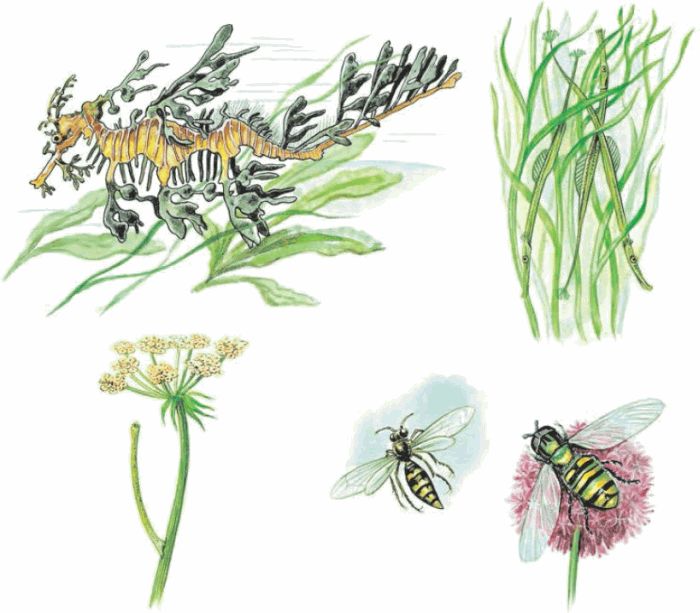
Rice. 74. Adaptations of organisms to the conditions of existence: examples of disguise and mimicry
So, the possibilities for evolutionary change in a population are always present. For the time being, they manifest themselves only in the variability of organisms. As soon as selection begins to act, the population responds to this with adaptive changes.
Forms of natural selection. Earlier, you were introduced to the two main forms of natural selection: stabilizing and moving. Recall that stabilizing selection aimed at maintaining existing phenotypes. Its action can be illustrated in Figure 75. This form of selection usually operates where the conditions of life remain constant for a long time, such as in northern latitudes or on the ocean floor.
The second form of natural selection is moving; as opposed to stabilizing, this form of selection promotes changes in organisms. As a rule, the action of natural selection becomes noticeable after long periods of time. Although sometimes motive selection can manifest itself very quickly in response to unexpected and strong changes in external conditions (Fig. 76). A classic example of the action of motive selection is provided by the study of pepper moths, which change color under the influence of soot emissions and the sooting of tree trunks in industrial areas of England in the 19th century. (Fig. 78).
The third form of natural selection is disruptive, or tearing. Disruptive selection leads to the emergence within populations of groups of individuals that differ in some way (color, behavior, space, etc.). Disruptive selection contributes to the maintenance of two or more phenotypes within populations and removes intermediate forms (Fig. 77). There is a kind of gap in the population on a certain basis. This phenomenon is called polymorphism. Polymorphism is characteristic of many species of animals and plants. For example, sockeye salmon, a salmon fish of the Far East that lives in the sea and breeds in small freshwater lakes connected to the sea by rivers, has a so-called “residential form”, represented by small dwarf males that never leave the lakes. Among some bird species (skuas, cuckoos, etc.), color morphs are common. There is seasonal polymorphism in the two-spotted ladybug. Of the two color forms, "red" ladybugs survive the winter better, while "black" ones survive the summer. The emergence of polymorphism, apparently, is largely determined by the heterogeneity (seasonal or spatial) of the living conditions of the population, which generates selection, leading to the emergence of specialized (corresponding to heterogeneous conditions) forms within the same population.
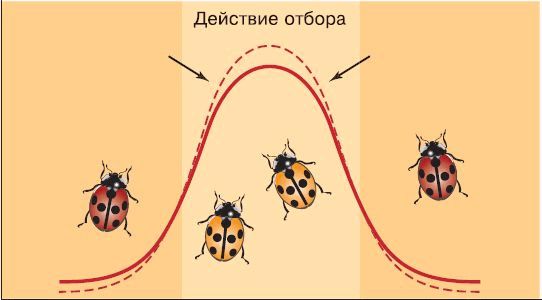
Rice. 75. Action of stabilizing selection
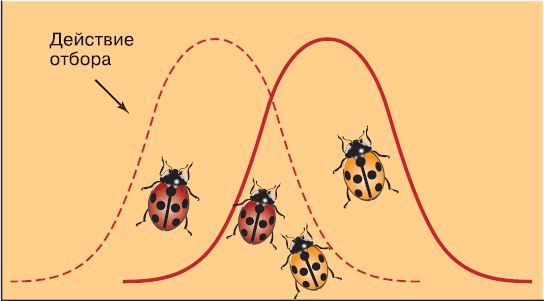
Rice. 76. Action of motive selection
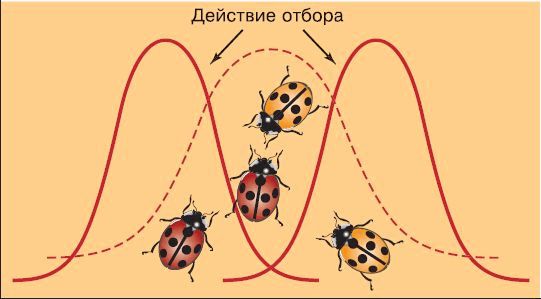
Rice. 77. Action of Disruptive Selection
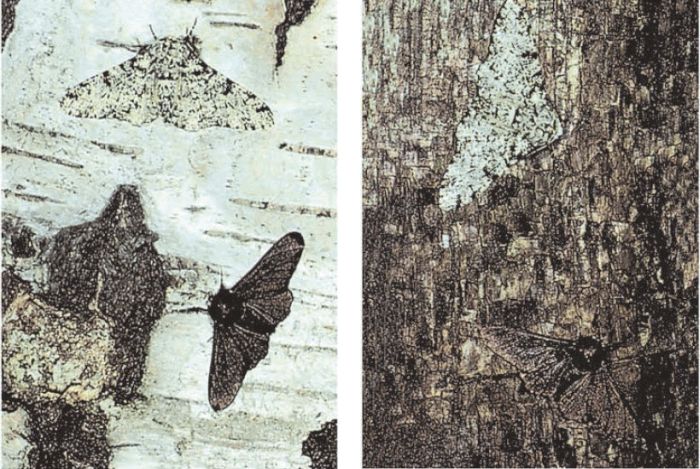
Rice. 78. Dark and light moths on tree trunks
The creative role of natural selection. It must be emphasized that the role of natural selection is reduced not only to the elimination of individual non-viable organisms. The driving form of natural selection preserves not individual characteristics of an organism, but their entire complex, all combinations of genes inherent in an organism. Natural selection is often compared to the work of a sculptor. Just as a sculptor creates a work of art from a shapeless block of marble that strikes with the harmony of all its parts, so selection creates adaptations and species, removing from the gene pool of populations that are inefficient from the point of view of survival genotypes. This is the creative role of natural selection, since the result of its action are new types of organisms, new forms of life.
Natural selection. biological adaptations. Forts of natural selection: stabilizing, driving, disruptive. Polymorphism.
1. What is fitness? Why is it relative?
2. What is stabilizing selection? Under what conditions is its effect most noticeable?
3. What is motive selection? Give examples of how it works. Under what conditions does this form of selection work?
4. What is the creative role of natural selection? Give an example proving that the action of selection is not limited to the elimination of individual traits that reduce the survival of organisms.
§ 59. Isolating mechanisms
1. What is the reason for the difference between the organisms discovered by Charles Darwin in the Galapagos Islands and closely related forms on the mainland?
2. What natural factors isolate some populations of organisms from other populations of the same species?
reproductive isolation. Natural selection can lead to the emergence and consolidation of genetic properties that distinguish populations from each other. As already mentioned, outwardly this manifests itself in the form of adaptations (adaptations) to specific living conditions. For example, populations of Atlantic herring in different areas of the ocean breed at different times of the year. There are spring, summer, autumn and winter spawning herring. The reproduction of each of them depends on the development of small plankton, which feed on herring larvae. Herring populations breed separately in different seasons, since in different latitudes the mass development of plankton occurs at different times of the year (spring, summer, autumn or winter). These populations belong to the same species and, despite small external differences and different breeding periods, can interbreed and produce fertile offspring. Perhaps in the future the differences between them will reach such a degree that it will lead to the loss of the ability of individuals of different populations to interbreed freely with each other, or to reproductive isolation between them.
What mechanisms underlie reproductive isolation? Is this simply due to geographical separation, or are there other mechanisms? The answers to these questions provide the key to understanding the mechanisms of speciation.
isolation mechanisms. In general, isolation mechanisms are divided into two main types. The first one belongs prezygotic mechanisms, i.e., zygotes preceding the formation, creating obstacles for mating of individuals belonging to different populations. The second type includes postzygotic mechanisms, acting after the formation of a zygote, leading to a decrease in the viability or fertility of the hybrid offspring.
Prezygotic isolating mechanisms are divided into groups depending on the factors that create an obstacle to mating of individuals.
Environmental isolation provided by environmental factors when populations occupy the same territory, but different habitats and therefore do not meet each other. temporary isolation- different breeding times, if mating in animals or flowering in plants occurs at different times of the year or at different times of the day. etiological, or behavioral, isolation- different behavior during the breeding season, which leads to a lack of mutual attractiveness of the male and female. Finally, differences in the size or shape of the genital organs, or in the structure of flowers, are achieved mechanical isolation.
Consider examples. The Hawaiian Islands are home to two species of fruit flies that are very similar in appearance. Both species live in the same places, feeding on the juice of the same woody plant. However, their ecological status is different. The first species spends its life in the crown of trees, feeding on the sap flowing down the trunks and branches of the upper tiers, and the second - in the forest floor, looking for puddles of sap that has dripped from the tree. Interbreeding between these species never occurs due to the spatial disunity that arises from different ecological specializations.
An interesting example of behavioral isolation is demonstrated by some species of fireflies. Each of the cohabiting species has its own light trajectory and its own types of emitted light signals. Trajectories can be zigzag, straight or in the form of a loop, and light pulsations are short or long in the form of stable reflections (Fig. 79). When mating, individuals select each other, strictly focusing on the type of light signal. This example shows that isolation between populations can be reinforced by the formation of certain types of behavior (the development of reflex reactions only to signals of that particular type).
In many animals, the breeding season begins with strictly defined combinations of external factors (for example, temperature or light). These factors act as signals to start mating. Different species react to the same factors in different ways, which is the reason for the discrepancy in breeding times. Figure 80 shows differences in breeding times for different amphibian species living in the same areas.
In animals with external fertilization (starfish and some types of mollusks), the role of isolating factors is played by differences in the structure of special protein molecules that bind sperm and eggs to each other. Being on the surface of the eggs, these molecules react only to spermatozoa of "their" species, which excludes the possibility of fusion of reproductive products of different species. In animals with internal fertilization, this role is played by differences in the structure of the genital organs.
Postzygotic isolating mechanisms are also divided into groups depending on whether they lead to developmental disorders of the hybrids themselves and ultimately to their non-viability or to the inability of the hybrids to produce full-fledged gametes.
Interspecific hybrids usually die quickly or remain infertile. For example, a mule - a hybrid of a horse and a donkey - is sterile, it cannot produce offspring due to the fact that its set of chromosomes prevents the normal passage of meiosis. Hybrids of white hare and brown hare, marten and sable are fruitless.
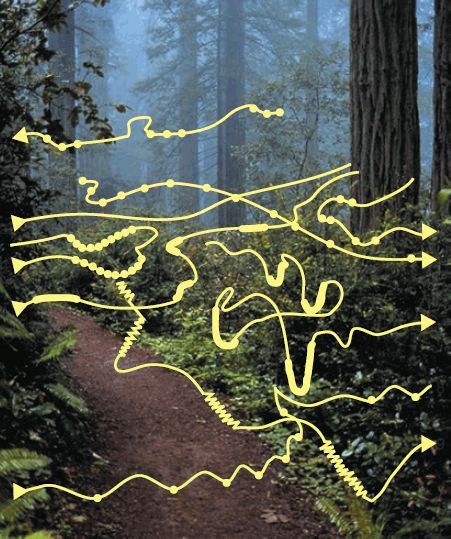
Rice. 79. Different types of light signals in different types of fireflies
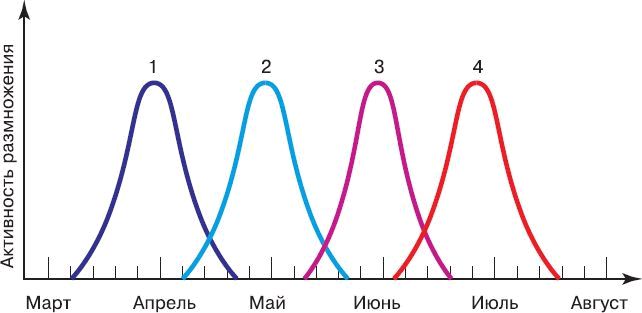
Rice. 80. Mismatch in terms of reproduction as an example of an isolating mechanism (1,2,3,4 - different types of amphibians)
Typically, reproductive isolation between species is maintained by several mechanisms. Temporal isolation is more common in plants, while ethological isolation is more common in animals.
reproductive isolation. Isolating mechanisms: prezygotic, postzygotic.
1. What are isolation mechanisms? What is the importance of isolation mechanisms?
2. What types of isolation mechanisms do you know? Give examples.
3. Why are hybrids of different types of organisms sterile?
A person often gets hybrids by crossing different species. In fish farms, for example, bester is bred - a hybrid of beluga and sterlet. In many countries, a hardy mule is used in agricultural work - a hybrid of a horse (mare) and a donkey (male), and in China - a hinny - a hybrid of a donkey with a stallion, despite the fact that the hinny is distinguished by its obstinacy, vicious disposition and is poorly tamed.
Discuss whether hybrid forms, when released into the wild, can lead to marked changes in the gene pool of wild populations or upset the ecological balance.

